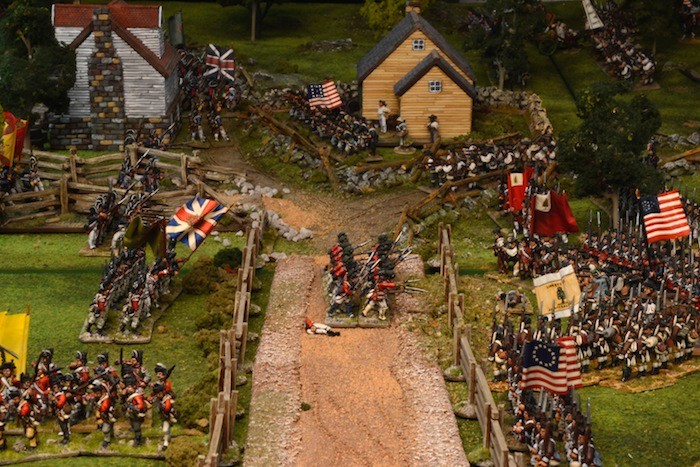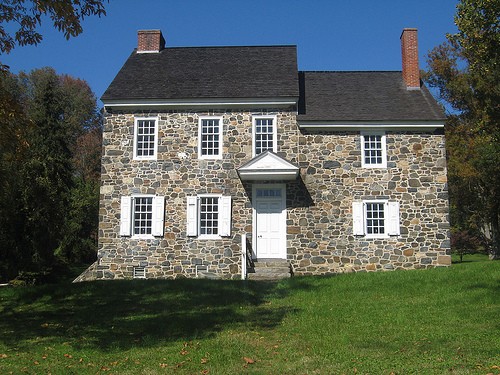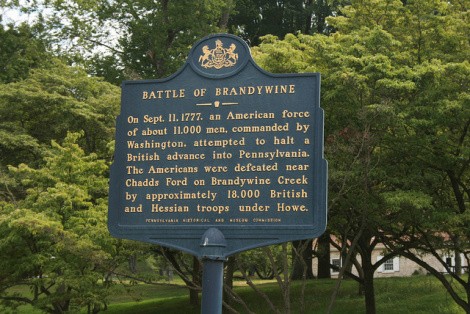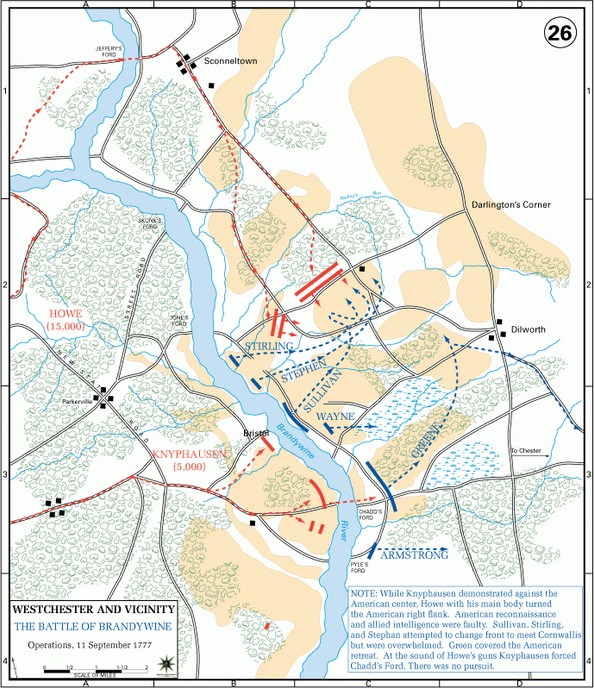Brandywine Battlefield Park
Introduction
Text-to-speech Audio
Images
The battle resulted in a victory for British General Howe's army and cleared the path for his men to capture Philadelphia despite Washington's original optimism that his men could stop Howe's army and turn them away from the rebel capital.

This house served as Washington's headquarters during the battle.

Historical marker at the site

This map depicts the movements of the American and British forces. Red dashed lines show how the British were able to flank the American right by crossing the river just to the north (Washington was unaware of this ford).

Backstory and Context
Text-to-speech Audio
The goal of British General Howe was to take Philadelphia, the location of the rebel government. In General Howe's mind, the success of this strategy would effectively put an end to the war. Howe approached from the Chesapeake, landing at Elk, Maryland, and marched his army toward Philadelphia.
General George Washington anticipated this move and was determined and confident that he and his troops could stop the British. General Washington chose the high ground of Chadd's Ford which also allowed men arriving from Baltimore and Philadelphia to cross the Brandywine River safely. As a result, Washington was able to choose his staging point and the place where his army would engage the British.
On the morning of September 9, 1777, Washington placed his troops strategically along the Brandywine River at all possible crossings. By placing his troops at the northernmost and southernmost fords of the river, Washington was hoping to force a battle at Chadd's Ford. A battle here would be strategically advantageous because they his men held the high ground. The closest unguarded ford was twelve miles upriver, so General Washington felt well prepared.
The British anticipated Washington's move and met at Kennett's Square to prepare a counter maneuver. A portion of the British army marched forth from Kennett's Square in order to trick Washington into thinking that they intended on meeting Washington at Chadd's Ford. In actuality, the majority of the British army had marched north and crossed a ford that General Washington had no knowledge of. They would then turn south and attack the flank of Patriot forces.
On September 11, 1777, the morning broke with a heavy, dense fog. The fog was so thick, that the movements of the approaching British forces were completely hidden. Washington began receiving reports that morning warning that General Howe had split his forces. However, other reports began trickling in that negated the previous reports. General Washington came to the mistaken conclusion that the entire British force was converging on Chadd's Ford, just as he had planned.
However, the reality of the situation was quite different. The British had crossed the river, marched south, and had taken up the position of their choosing near Birmingham Friends Meeting House. Washington was shocked when the British appeared on his right flank and ordered his troops to take and control the high ground around Birmingham Friends Meeting House. The Continentals were unable to carry out Washington's order despite a valiant effort in a battle that ended when it became too dark to continue. The Americans pulled back and the British were too exhausted to give chase. As a result, the British controlled the field and had a route to take Philadelphia and other cities, but the American rebel army had not been defeated and would continue the war despite the loss of Philadelphia to the British on September 26th.
Sources
Greenwood, Richard E. "Brandywine Battlefield Park." National Park Service - National Register of Historic Places Nomination Form.
"History of the Battle of the Brandywine." Independence Hall Association. Accessed June 1, 2015. http://www.ushistory.org/brandywine/index.htm.
Logan, Joseph T. "The Battle of Brandywine." theamericanrevolation.org. Accessed June 1, 2015. http://www.theamericanrevolution.org/battledetail.aspx?battle=16.
